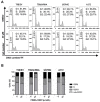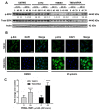Sensitivity to PRIMA-1MET is associated with decreased MGMT in human glioblastoma cells and glioblastoma stem cells irrespective of p53 status
- PMID: 27533246
- PMCID: PMC5312382
- DOI: 10.18632/oncotarget.11197
Sensitivity to PRIMA-1MET is associated with decreased MGMT in human glioblastoma cells and glioblastoma stem cells irrespective of p53 status
Abstract
Alterations of the TP53 tumor suppressor gene occur in ~30% of primary glioblastoma (GBM) with a high frequency of missense mutations associated with the acquisition of oncogenic "gain-of-function" (GOF) mutant (mut)p53 activities. PRIMA-1MET/APR-246, emerged as a promising compound to rescue wild-type (wt)p53 function in different cancer types. Previous studies suggested the role of wtp53 in the negative regulation of the DNA repair protein O6-methylguanine-DNA methyltransferase (MGMT), a major determinant in resistance to therapy in GBM treatment. The potential role of MGMT in expression of p53 and the efficacy of PRIMA-1MET with respect to TP53 status and expression of MGMT in GBM remain unknown. We investigated response to PRIMA-1MET of wtp53/MGMT-negative (U87MG, A172), mutp53/MGMT-positive U138, LN-18, T98/Empty vector (T98/EV) and its isogenic MGMT/shRNA gene knockdown counterpart (T98/shRNA). We show that MGMT silencing decreased expression of mutp53/GOF in T98/shRNA. PRIMA-1MET further cleared T98/shRNA cells of mutp53, decreased proliferation and clonogenic potential, abrogated the G2 checkpoint control, increased susceptibility to apoptotic cell death, expression of GADD45A and sustained expression of phosphorylated Erk1/2. PRIMA-1MET increased expression of p21 protein in U87MG and A172 and promoted senescence in U87MG cell line. Importantly, PRIMA-1MET decreased relative cell numbers, disrupted the structure of neurospheres of patient-derived GBM stem cells (GSCs) and enabled activation of wtp53 with decreased expression of MGMT in MGMT-positive GSCs or decreased expression of mutp53. Our findings highlight the cell-context dependent effects of PRIMA-1MET irrespective of p53 status and suggest the role of MGMT as a potential molecular target of PRIMA-1MET in MGMT-positive GSCs.
Keywords: MGMT; PRIMA-1MET/APR-246; glioblastoma; glioblastoma stem cells; p53 mutation.
Conflict of interest statement
The authors declare no conflict of interest.
Figures









Similar articles
-
MEK-ERK signaling dictates DNA-repair gene MGMT expression and temozolomide resistance of stem-like glioblastoma cells via the MDM2-p53 axis.Stem Cells. 2011 Dec;29(12):1942-51. doi: 10.1002/stem.753. Stem Cells. 2011. PMID: 21957016
-
GADD45A plays a protective role against temozolomide treatment in glioblastoma cells.Sci Rep. 2017 Aug 18;7(1):8814. doi: 10.1038/s41598-017-06851-3. Sci Rep. 2017. PMID: 28821714 Free PMC article.
-
All-Trans Retinoic Acid Induces Differentiation and Downregulates Stemness Markers and MGMT Expression in Glioblastoma Stem Cells.Cells. 2025 May 20;14(10):746. doi: 10.3390/cells14100746. Cells. 2025. PMID: 40422249 Free PMC article.
-
Regulation of expression of O6-methylguanine-DNA methyltransferase and the treatment of glioblastoma (Review).Int J Oncol. 2015 Aug;47(2):417-28. doi: 10.3892/ijo.2015.3026. Epub 2015 May 29. Int J Oncol. 2015. PMID: 26035292 Free PMC article. Review.
-
Cancer Stem Cells and Chemoresistance in Glioblastoma Multiform: A Review Article.J Stem Cells. 2015;10(4):271-85. J Stem Cells. 2015. PMID: 27144829 Review.
Cited by
-
PRIMA-1MET-induced neuroblastoma cell death is modulated by p53 and mycn through glutathione level.J Exp Clin Cancer Res. 2019 Feb 12;38(1):69. doi: 10.1186/s13046-019-1066-6. J Exp Clin Cancer Res. 2019. PMID: 30755224 Free PMC article.
-
Targeting cIAP2 in a novel senolytic strategy prevents glioblastoma recurrence after radiotherapy.EMBO Mol Med. 2025 Apr;17(4):645-678. doi: 10.1038/s44321-025-00201-x. Epub 2025 Feb 19. EMBO Mol Med. 2025. PMID: 39972068 Free PMC article.
-
UBE2C enhances temozolomide resistance by regulating the expression of p53 to induce aerobic glycolysis in glioma.Acta Biochim Biophys Sin (Shanghai). 2024 Jun 25;56(6):916-926. doi: 10.3724/abbs.2024033. Acta Biochim Biophys Sin (Shanghai). 2024. PMID: 38634120 Free PMC article.
-
Innovative therapies for malignant brain tumors: the road to a tailored cure.Acta Biomed. 2020 Jun 30;91(7-S):5-17. doi: 10.23750/abm.v91i7-S.9951. Acta Biomed. 2020. PMID: 32608372 Free PMC article.
-
Combined Delivery of Temozolomide and siPLK1 Using Targeted Nanoparticles to Enhance Temozolomide Sensitivity in Glioma.Int J Nanomedicine. 2020 May 12;15:3347-3362. doi: 10.2147/IJN.S243878. eCollection 2020. Int J Nanomedicine. 2020. PMID: 32494134 Free PMC article.
References
-
- Goodenberger ML, Jenkins RB. Genetics of adult glioma. Cancer Genet. 2012;205:613–621. - PubMed
-
- Louis DN, Perry A, Reifenberger G, von Deimling A, Figarella-Branger D, Cavenee WK, Ohgaki H, Wiestler OD, Kleihues P, Ellison DW. The 2016 World Health Organization Classification of Tumors of the Central Nervous System: a summary. Acta Neuropathol. 2016;131:803–820. - PubMed
-
- Zhang J, Stevens M, Bradshaw T. Temozolomide: mechanisms of action, repair and resistance. Curr Mol Pharmacol. 2012;5:102–114. - PubMed
-
- Anton K, Baehring JM, Mayer T. Glioblastoma multiforme: overview of current treatment and future perspectives. Hematol Oncol Clin North Am. 2012;26:825–853. - PubMed
MeSH terms
Substances
LinkOut - more resources
Full Text Sources
Other Literature Sources
Molecular Biology Databases
Research Materials
Miscellaneous

